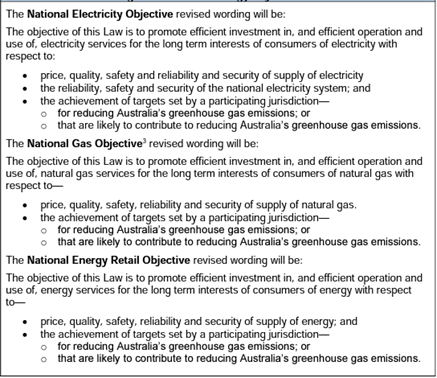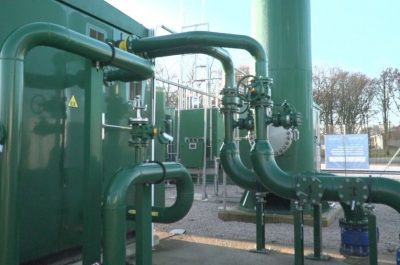Putting the new national energy objectives to work
As energy market bodies seek to implement the amended national energy objectives, we take a look at what harmonisation changes are needed in our national energy rules to incorporate the emissions reduction objective, and how the reform will be applied by the market bodies.
Energy objectives: old and new
In the biggest reform since the objectives were first developed, Australia’s national energy laws will be amended to include an emissions reduction objective into the national energy objectives.
As we previously explored, the national electricity objective and national gas objective (referred to collectively as the ‘national energy objectives’ alongside the related national energy retail objective) govern and guide market bodies such as the Australian Energy Market Commission (AEMC), the Australian Energy Market Operator (AEMO) and Australian Energy Regulator (AER) in their decisions under energy law.

Figure 1: Revised wording of the national energy objectives[i]
As shown in Figure 1 above, including the words ‘or likely to contribute to’ in the emissions reduction objective reflects the intent that targets that may not be promoted primarily for reducing emissions, but which would contribute to that goal (such as renewable energy targets or electric vehicle targets), could be captured under the amended objectives.
Importantly, the new emissions reduction objective is not intended to sit above, or be prioritised over, the existing components within the energy objectives, but rather will be considered and balanced alongside the other existing components, such as price, quality, and reliability, to maximise the overall objective.
Energy networks, through the Energy Minister’s prior consultation, strongly supported the introduction of an emissions reduction component into the national energy objectives, noting that it signals governments’ commitment to achieve a decarbonised, modern and reliable energy grid.
Changes to the national energy laws are, however, only the first step to implementing this significant reform. There is now an immediate need for changes to our national energy rules to make sure that market bodies, such as the AER, can fully and properly reflect the policy intent when making energy regulatory decisions critical to the community and the energy transition.
The next step: harmonising our national energy rules
The purpose of the emissions amendments in our national energy laws is to provide greater clarity to Australia’s three energy market bodies – AEMC, AEMO & AER – to explicitly consider emissions reduction in how each market body undertakes its powers and functions.
Without consistent and corresponding changes to our national energy rules, there are likely to be some important decisions where the impact of the changes to the national energy objectives could be unintentionally muted. To address this risk, Energy Senior Officials recently submitted rule change requests to the AEMC that seek to harmonise the rules with the changes to the law.
Expenditure rules
The existing capital and operating expenditure guidance in the electricity and gas rules is prescriptive, and largely replicates the core of the existing ‘old’ national electricity and gas objectives, without explicitly referencing the national electricity objective (NEO) or the national gas objective (NGO).
For example, the electricity distribution capital expenditure guidance in the national electricity rules is solely focused on meeting demand, complying with regulatory obligations and maintaining safety, quality, reliability and security of supply of standard control services – they do not refer to the achievement of emissions reduction targets.
This means, without these changes to the rules, capital and operating expenditure plans directed at meeting emissions reduction may not be able to satisfy the rule requirements, unless that expenditure is, for example, also required to meet demand. Clarification through the consequential rule amendments currently proposed by Energy Senior Officials would remove the risk of this unanticipated outcome and is strongly supported by networks.
Investment and planning rules
Likewise, there are some investment and planning rules related to regulatory investment tests (RITs) and the Integrated System Plan (ISP) that don’t explicitly consider emission reduction benefits and should therefore be updated to align with the updated NEO.
In particular, the current classes of “market benefits” (e.g., benefits which can be assessed when comparing or assessing potential investments) under the ISP and RIT frameworks reflect the existing components of the NEO as they largely relate to price, quality, safety, reliability and security. Including emissions reduction as a new class of market benefit will give effect to the policy intent of changes to the NEO. This is made clear in the Second Reading Speech for the Bill which notes that the legislative intent of the reform is for the reduction of greenhouse gas emissions to be “a new category of market benefit to be assessed in market body decisions”.
These consequential rule changes are thus key to delivering on the intent of the agreed policy changes.
Putting the reforms to work day-to-day
The AER and AEMC also recently released draft guidance on how they will apply the emissions component of the national energy objectives, which is an important step in assisting participants in understanding how the reform will impact their day-to-day decision-making tasks.
The targets statement, which will list the government emission reduction targets that the market bodies should consider when applying the amended objectives, will be an important element to operationalising the reform.
Also critical will be forthcoming guidance on the value of emissions reduction (VER) being prepared by the Commonwealth Government and the work the AEMC is undertaking to estimate the volume of emission reductions for rule changes. Together these will be key to encoding this reform in decisions across the sector.
Network service providers are essential partners in supporting government commitments to achieve a decarbonised, modern, and reliable grid, and look forward to working closely with market bodies, consumers, and stakeholders to implement this important reform.
[i] DCCEEW, Information Paper: Incorporating an emissions reduction objective into the national energy objectives, Table 2, May 2023



